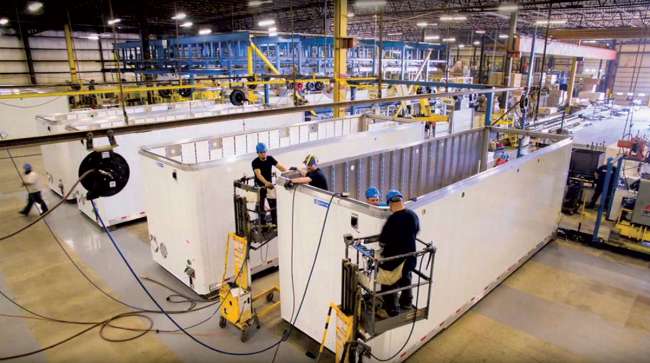Staff Reporter
Trailer Orders Fall Amid Weak Order Season

[Stay on top of transportation news: Get TTNews in your inbox.]
U.S. trailer orders in January declined sequentially and from the prior year, according to ACT Research.
Preliminary data for the month showed orders fell 43.6% to 13,700 units from 24,300 in 2023. They also dropped the same amount sequentially from the prior month’s preliminary total of 24,300 units. It was the first sequential decline for trailer orders since November. ACT Research also noted the seasonal adjustment was even less since this still is usually peak order season.
“With the pent-up demand enjoyed by the industry during the past few years largely extinguished, a softer opening to 2024 meets expectations,” said Jennifer McNealy, director of commercial vehicle market research and publications at ACT. “Net orders are being challenged by a backdrop of weak profitability for for-hire truckers, and anecdotal commentary from trailer manufacturers throughout the past several months have been indicating this slowing.”
McNealy added that these manufacturers have shared that orders are coming, but not at the rapid pace that they have the past few years, and noted the lower orders don’t indicate a catastrophic year — just not a stellar one. She also indicated cancellations have oscillated above comfortable levels for most segments in January.

"A softer opening to 2024 meets expectations,” ACT Research's Jennifer McNealy says of the trailer market. (ACT Research)
“We’re still seeing a lot of the same of what we saw at the end of last year, where fleets are still sitting on excess capacity and trying to find places to park trailers, trying to purge equipment from their fleet and unwind from all the excess capacity that’s been in the market for the last year,” said Brandon Lairsen, vice president of trailer leasing at Transport Enterprise Leasing. “We are starting to hear more fleets talk in terms of more specific needs than what we heard last year for the second, third and fourth quarter of this year.”

Lairsen
Lairsen added that part of that push comes from carriers anticipating a freight market upswing in the back end of the year. He also observed equipment utilization levels remain below where they need to be for that trailer market to start showing marked improvement.
“I think a lot of fleets are looking at, we’re going to have to start replacing trailers this year,” Lairsen said. “There is a big opportunity for people sitting on equipment to purge older stuff and are now starting to look at newer stuff as the prices are really started to come back down to earth.”
He said the trailer market essentially is waiting to rightsize and for demand to pick up before a turnaround can take hold. He pointed out carriers that were reliant on the spot market continue to leave the industry with conditions having gone from robust to slow. He sees capacity leaving the market as being a key component for fleets buying equipment.

Kenney
“Hyundai Translead is certainly not immune to the current environment and has felt the slowdown in orders as indicated by the most recent ACT report,” Hyundai Translead CEO Sean Kenney said. “Customers continue to be challenged by the current operating environment and as such have taken a more conservative approach to their equipment needs. We are hopeful that fleets will see improved operating results coming out of the first quarter allowing them to invest more in future equipment needs.”
Jeremy Sanders, chief commercial officer at Stoughton Trailers, said that the trailer market has remained about the same since midway through last year. The problem is, the freight market has been dealing with the same economic conditions with the slowdown in demand and less rate pressure.

Sanders
“I think customers are continuing to really scrutinize capital spend,” Sanders said. “The freight environment, it seems like there’s good news one minute and then bad news. It’s a varied situation, but contract rates and spot rates are still in an unhealthy place.
“I think that profitability is challenged as the contract and spot rates remain in a place that is not so healthy. I think all that rolls in together to a place where demand continues to be soft.”
Sanders noted that some of the smaller to midlevel players are anxiously awaiting an understanding of interest rates as well. He continues to see mixed signals from the macroeconomic environment that are causing caution and additional scrutiny.
“It’s really a bit of a bifurcated situation,” Sanders said. “It’s certainly not one-size-fits-all. Some are doing better than others, but generally speaking, the higher interest rates, the challenged profitability and the general lack of freight is putting a compression kind of state on the industry.”
Want more news? Listen to today's daily briefing below or go here for more info:




